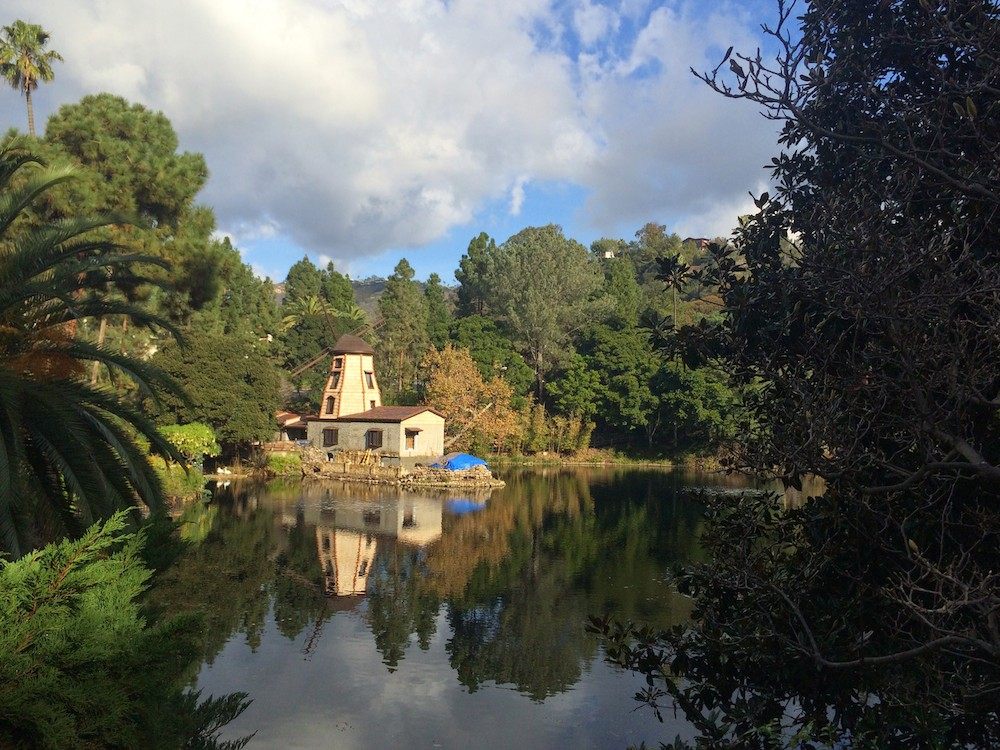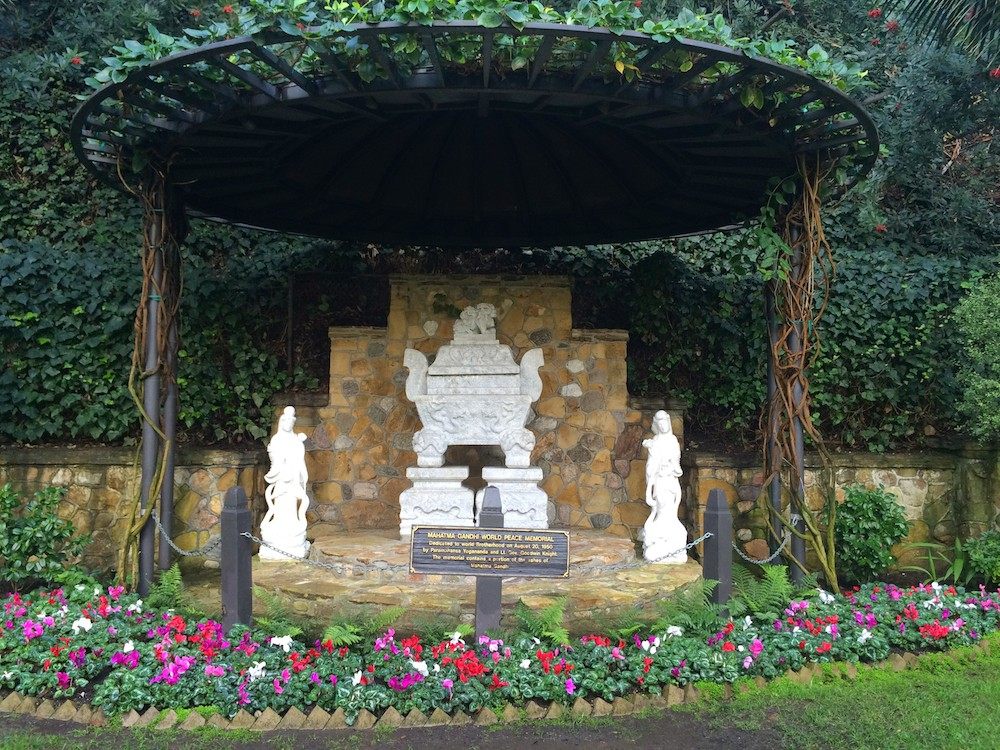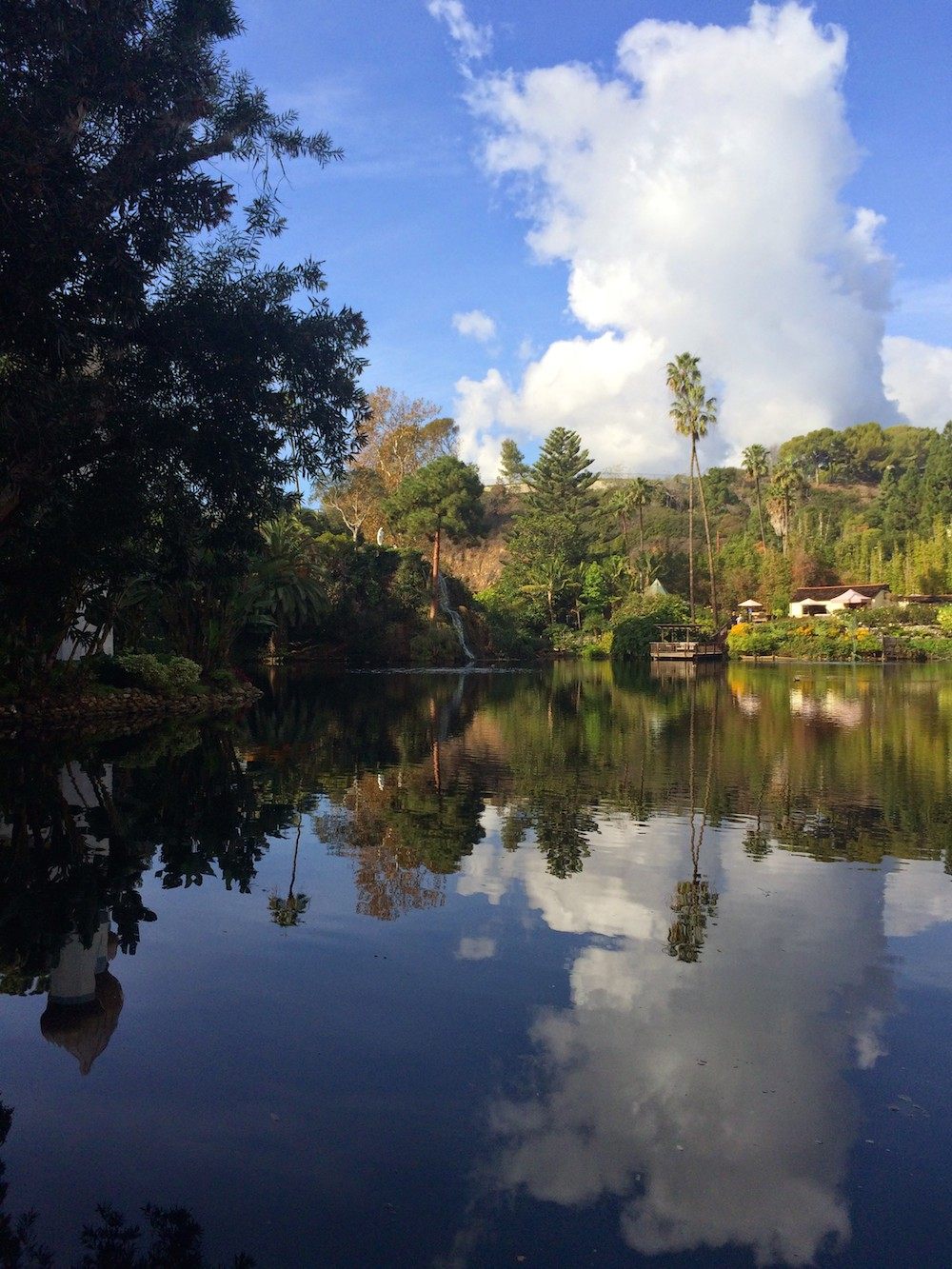How Gandhi’s Ashes Landed in Los Angeles
 Self-Realization Fellowship Lake Shrine (all photographs by the author unless indicated)
Self-Realization Fellowship Lake Shrine (all photographs by the author unless indicated)
There is perhaps no more beautiful spot in Los Angeles than the Self-Realization Fellowship Lake Shrine in Pacific Palisades. Overlooking the Pacific Ocean, this meditation garden and shrine is operated by the Self-Realization Fellowship (SFR), a religious order that follows the principles of Yogi Paramahansa Yogananda (1893-1952). The lakeshore is dominated by the Golden Lotus Archway, a “wall-less temple.” Behind this white archway is the Gandhi World Peace memorial, dedicated by Yogananda in 1950, which features an ancient Chinese sarcophagus containing some of the ashes of Mohandas K. Gandhi, India’s martyred liberator. The story of how the ashes got to Los Angeles is part of a broader story — a tale of family feuds, intrigue, and national politics — that has still not been fully resolved.
When Gandhi was assassinated on January 10, 1948 by a Hindu extremist, he had every reason to believe that all his earthly remains would be taken to the sacred city of Allahabad and poured into holy Ganges River at its confluence with Jumna, per Hindu tradition and his wishes. His body was cremated, and afterwards bone fragments were sifted by his two younger sons (noticeably absent was the troubled Harilal, his estranged eldest son) and, according to reports, “dipped in red earthen brass pots containing milk and honey from the Jumna.” The remains then took one last journey by a flower and incense filled third-class train from New Delhi to Allahabad. On February 13, the Los Angeles Times reported that the ashes of Gandhi had joined “the immortals in heaven”:
Devadas and Ramdas Gandhi, the martyred leader’s sons, tilted the urn and spilled the cremated remains into the muddy green holy water from a white-painted wartime “duck.” A crowd estimated at between two million and three million lined the funeral procession or massed on the sandy river bank. As the ashes touched the water, the multitudes joined in a great roar of “Mahatma Gandhi ki jai” — victory to Mahatma Gandhi. Some wept. Some stood mute, their hands clasped before their faces.

 Gandhi’s funeral (1948 photograph, via Wikimedia)
Gandhi’s funeral (1948 photograph, via Wikimedia)
 Gandhi’s cremation (1948 photograph, via Wikimedia)
Gandhi’s cremation (1948 photograph, via Wikimedia)
 Consigning Gandhi’s ashes to the Ganges (1948 photograph, via Wikimedia)
Consigning Gandhi’s ashes to the Ganges (1948 photograph, via Wikimedia)
But not all of the remains took the long train ride from New Deli to Allahabad. To appease the mourning Indian public, steel urns containing Gandhi’s ashes were sent all over the country for public services meant to end in their dispersal in local bodies of water. This does not seem to have happened in every case, and portions of the ashes were kept by government agents and friends of Gandhi. Some made their way to the Aga Khan, who enshrined them at his palace in Pune India. Yogananda in Los Angeles, who had a friendship with Gandhi spanning decades (he is said to have initiated Gandhi into the practice of Kriya Yoga in 1930), received his portion of remains from Dr. V.M. Nawle, a journalist who was friends with both men.
He wrote to Yogananda: “Regarding Gandhi ashes, I may say that [they] are scattered and thrown in almost all important rivers and seas, and nothing is given outside India except the remains which I have sent to you after a great ordeal. You are the only one in the whole world who received Gandhi ashes outside India.”
 Memorial for Gandhi’s ashes at the Self-Realization Fellowship Lake Shrine
Memorial for Gandhi’s ashes at the Self-Realization Fellowship Lake Shrine
This statement proved to be false. Over the past two decades, Gandhi’s ashes have been found in several locations. In 1996, India’s Supreme Court ruled that a box of ashes, long held in secret in a bank vault at the State Bank of Calcutta, be returned to Gandhi’s great-grandson, who then returned them to the Ganges River. In 2008, the family requested that ashes given to a museum in Mumbai by an unnamed businessman be given back to the family. These were scattered into the Arabian Sea by Harilal’s daughter, Parikh. In both cases, the family felt that in honoring Gandhi’s final wishes, they had completed Harilal’s duties to his estranged father, and thus healed the family’s wounds. Most surprisingly, in 2010, ashes from a steel urn kept in secret for decades by a family friend in South Africa (where Gandhi began his activism) were scattered off the coast of that country.
It is likely that there are still more of Gandhi’s remains in little steel urns around the world. And though there have been conflicting reports on whether the family wishes the ashes to remain in Los Angeles, in 2008, his great-grandson commented on the two known shrines at the Aga Kahn Palace and SRF Lake Shrine:
Taking these out would require breaking the shrines which the family does not want. I hope there are no more out there. The family is aware that the ashes could be misused by politically motivated people and damage the Mahatma’s name.
So for now, a little bit of this immortal leader rests in this quaint lakeside oasis, for all Angelinos to revere.
 Self-Realization Fellowship Lake Shrine
Self-Realization Fellowship Lake Shrine







Follow us on Twitter to get the latest on the world's hidden wonders.
Like us on Facebook to get the latest on the world's hidden wonders.
Follow us on Twitter Like us on Facebook